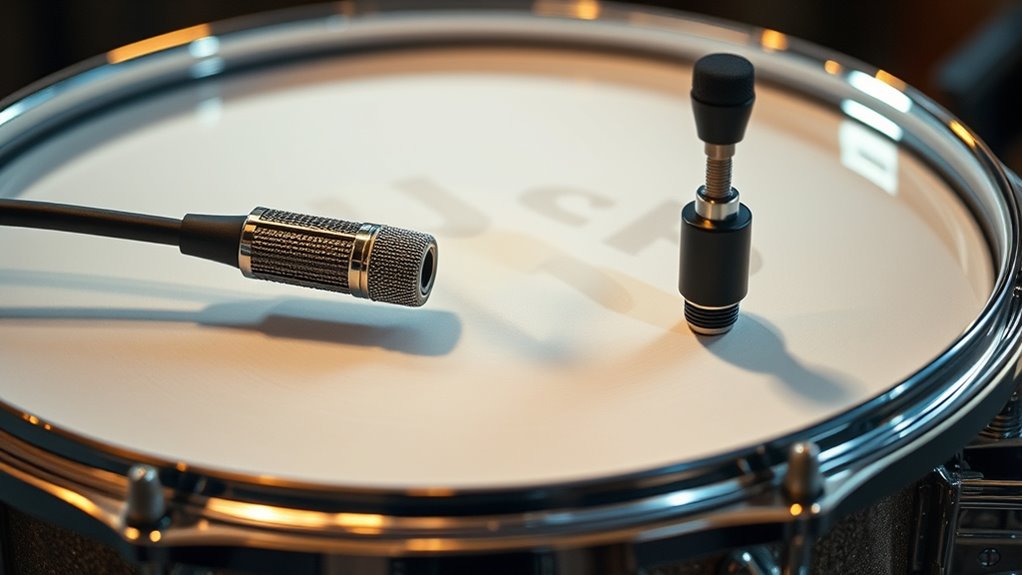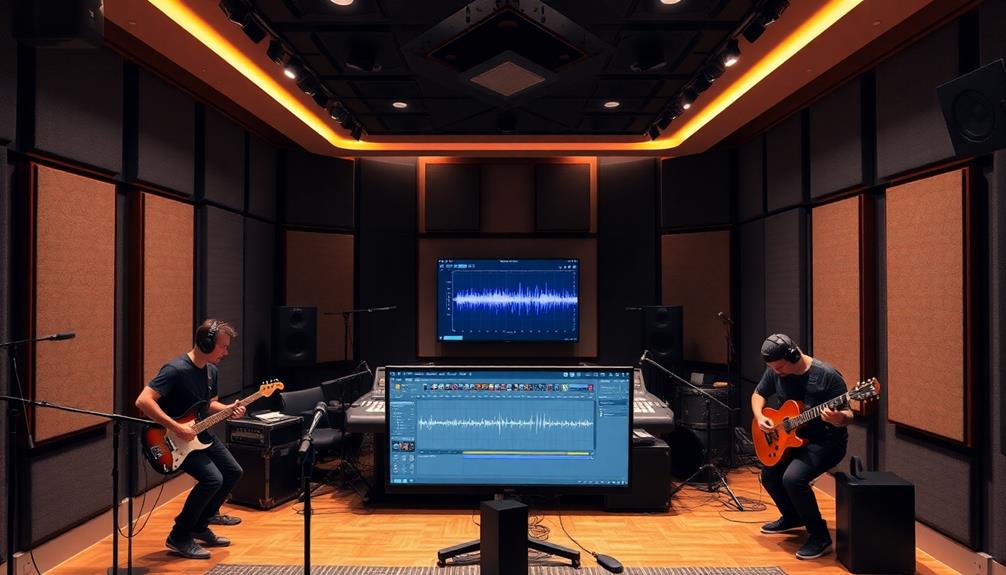To achieve a professional drum sound, you need to focus on proper tuning and phase alignment. Tune your drums evenly to create a full, lively resonance without dullness or harshness. Check for phase issues by flipping microphone polarity or using phase meters, ensuring your signals stay in phase for a tight, cohesive sound. Fine-tuning these aspects enhances clarity and power—keep exploring these techniques to master your drum production.
Key Takeaways
- Proper drum tuning enhances resonance, clarity, and ensures the drum blends well with other instruments.
- Even tensioning of drumheads prevents dull or harsh sounds, creating a full, lively tone.
- Phase alignment between microphones prevents sound cancellation, ensuring a cohesive and powerful drum sound.
- Flipping mic polarity and using phase meters help detect and correct phase issues during recording or mixing.
- Combining correct tuning with phase coherence results in a balanced, professional drum sound.

Achieving a professional drum sound starts with proper tuning and phase alignment. When you tune your drums correctly, you enhance their natural resonance, which is crucial for creating a full, lively sound. Drum resonance refers to how well the drum body amplifies the vibrations produced by striking the drumhead. If the drum is tuned too high or too low, it can produce dull or overly harsh tones, undermining your overall mix. To avoid this, you need to find the sweet spot where the drumhead vibrates freely without sounding out of tune. This process involves adjusting the tension rods evenly around the drum, listening carefully to the pitch, and ensuring each lug is tightened incrementally. Proper tuning not only improves drum resonance but also guarantees the sound is clear and balanced, making it easier to blend with other instruments.
Once your drums are tuned, phase alignment becomes the next critical step. When multiple microphones capture the same drum, phase issues can occur, leading to phase cancellation. Phase cancellation happens when sound waves from different microphones interfere destructively, causing a thin or hollow sound, or even making some drum hits almost disappear. This problem is common when close miking and overhead miking are combined. To prevent this, you need to check the phase relationship between your microphones. One quick way is to flip the polarity of one microphone and listen for a fuller, more focused sound. If the sound improves, you’re likely experiencing phase cancellation and should keep the polarity flipped. Proper phase alignment ensures that all your microphones work together harmoniously, capturing the full power and resonance of your drums without losing crucial frequencies.
You can also use tools like phase meters or digital audio workstations (DAWs) that feature phase correlation meters to visualize your phase relationship. When you see negative correlation, it indicates phase issues that need fixing. Adjust the microphone placement or use phase correction plugins to align the signals better. Remember, even tiny shifts in mic position can profoundly impact phase coherence, so take your time to fine-tune your setup. When both your tuning and phase are on point, your drum sounds will be punchy, warm, and cohesive, whether you’re recording or performing live.
Frequently Asked Questions
How Often Should I Retune My Drums for Optimal Sound?
You should retune your drums regularly, ideally before every recording session or gig, to guarantee ideal sound. The tuning frequency depends on your drum head selection and playing style, but check your drums weekly if you play often. Keep an ear out for dull or unwanted overtones, and adjust accordingly. Consistent tuning helps maintain the desired tone and prevents tuning drift over time.
What Tools Are Best for Precise Drum Tuning?
Did you know that 85% of professional drummers swear by digital tuners? For precise drum tuning, use a digital tuner or tuning app to achieve consistent pitch. Start with quality drum head selection to match your sound goals. Tuning frequency depends on your playing style, but regularly checking and adjusting your drum heads ensures your drums stay in perfect harmony. These tools help you maintain ideal sound effortlessly.
How Does Room Acoustics Affect Phase Alignment?
Room reflections and acoustic treatment considerably impact phase alignment because they alter how sound waves interact and reach your ears. If reflections cause overlapping signals, they can create phase issues, making your drums sound muddy or unbalanced. By properly treating your room, reducing unwanted reflections, and controlling acoustics, you guarantee clearer phase alignment, resulting in a tighter, more focused drum sound that accurately translates across different playback systems.
Can Phase Issues Be Fixed After Recording?
Yes, you can fix phase issues after recording through phase correction techniques. Use audio editing software to adjust timing synchronization between tracks, aligning waveforms precisely. This process helps eliminate phase cancellations and enhances clarity. By carefully applying these adjustments, you improve the overall sound quality. Remember, subtle tweaks often yield the best results, ensuring your recordings sound tight and well-balanced without compromising the original performance.
What Are Common Signs of Poor Drum Phase Alignment?
Poor drum phase alignment is like a choir singing out of sync, causing phase cancellation that muddles your sound. You’ll notice a thin, hollow tone or a loss of punch, especially in the low end. If your drums sound less clear or lack depth when multiple mics are used, it’s a sign your phase isn’t aligned properly. Fixing this restores sound clarity, making your drums punch through with full presence.
Conclusion
Mastering drum tuning and phase alignment can elevate your recordings considerably. When done correctly, you’ll notice a tighter, more cohesive sound that resonates with listeners. Did you know that improperly phased drums can reduce overall volume by up to 60%? By paying attention to tuning and phase, you guarantee your drums sound punchy and clear, making your mixes stand out. Keep experimenting, and you’ll create professional-quality tracks that truly hit hard.









